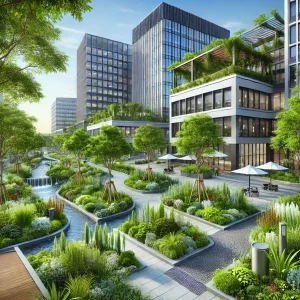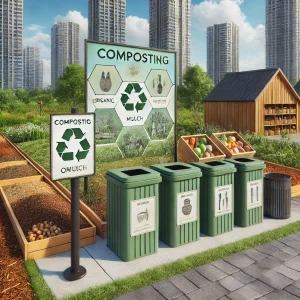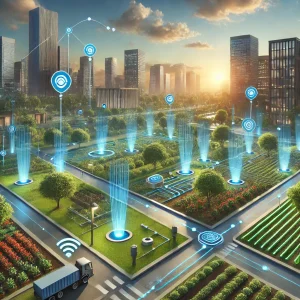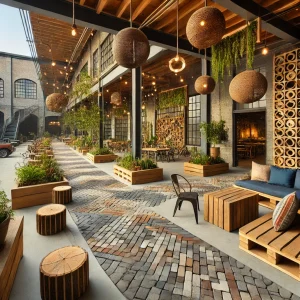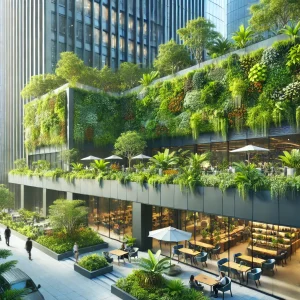As sustainability takes center stage in urban development, the concept of the circular landscape is gaining traction in commercial landscaping. This approach redefines traditional landscape management by minimizing waste and maximizing resources through closed-loop systems. For businesses and property managers in British Columbia, integrating circular landscaping practices can lead to lower maintenance costs, improved environmental impact, and enhanced green credentials.
In this blog, we explore the principles of circular landscaping, key strategies, real-world applications, and future trends that will shape the industry in 2025 and beyond.
What Is the Circular Landscape Approach?
The circular landscape is an extension of the circular economy concept, where materials are continuously repurposed, and waste is minimized through strategic reuse. Unlike traditional landscaping—where resources like water, soil, and organic matter are often wasted— the circular landscape prioritizes regeneration, recycling, and efficiency.
In commercial properties such as corporate campuses, public spaces, and business districts, this model is becoming increasingly popular. Not only does it reduce environmental impact, but it also lowers operational costs and helps businesses comply with sustainability regulations in British Columbia. Moreover, it aligns with growing corporate responsibility initiatives, making it a forward-thinking approach for businesses.
Key Strategies for Circular Landscaping
1. Composting and Soil Regeneration
Organic waste, including grass clippings, pruned branches, and fallen leaves, is often discarded in traditional landscaping. However, in a circular system, on-site composting transforms this waste into nutrient-rich soil amendments. As a result, businesses can install dedicated composting stations to process green waste, which significantly reduces landfill contributions and improves soil health. In turn, this enhances plant growth and reduces the need for synthetic fertilizers.
Example: IslandEarth Landscape Company in British Columbia uses composting systems in commercial landscapes to enrich soil without synthetic fertilizers.
2. Water Recycling and Rainwater Harvesting
Water is a critical yet finite resource in landscaping. To address this challenge, circular landscapes incorporate several water-saving methods:
- Rainwater harvesting systems collect and store water for irrigation.
- Greywater recycling repurposes non-potable water from buildings for landscape use.
- Smart irrigation systems optimize water usage based on real-time weather conditions.
By implementing these solutions, businesses can significantly reduce water consumption, which is particularly valuable in drought-prone areas like Vancouver Island. Furthermore, these methods contribute to long-term sustainability and cost savings.
3. Repurposing Plant Materials and Green Waste
In circular landscaping, plant waste is not discarded—it is repurposed in multiple ways. For example, trees removed from properties can be converted into mulch instead of being hauled away. Similarly, perennials and shrubs can be divided and replanted, reducing the need for new plant purchases. As a result, businesses can lower costs while promoting biodiversity.
Example: A Vancouver office park recently transitioned to a zero-waste landscaping policy, where all green waste is composted or repurposed for mulch. As a result, the company saved thousands in disposal fees while improving soil fertility.
4. Upcycling Hardscape Materials
Traditional landscaping involves extracting new materials, which often leads to environmental degradation. Instead, circular landscaping focuses on upcycling existing materials. Some common practices include:
- Reclaimed bricks and stones can be used for pathways and seating areas.
- Recycled composite wood is an excellent alternative for fencing and decking.
- Salvaged concrete can be crushed and repurposed as gravel for new construction.
Not only do these practices reduce costs, but they also lower the project’s carbon footprint while giving landscapes a distinct, eco-friendly aesthetic. Moreover, using upcycled materials enhances the uniqueness and character of commercial outdoor spaces.
5. Closed-Loop Design Systems
Circular landscaping integrates self-sustaining systems that contribute to overall landscape health. Some of these include:
- Pollinator-friendly plantings that encourage biodiversity and reduce the need for chemical pesticides.
- Permeable paving solutions that allow rainwater infiltration, preventing runoff.
- Living walls and green roofs that improve insulation and reduce heat island effects.
By incorporating these elements, businesses can create landscapes that are not only visually appealing but also environmentally responsible. In addition, these systems contribute to greater ecological balance and long-term sustainability.
Real-World Impact: British Columbia’s Circular Landscaping Initiatives
British Columbia is at the forefront of sustainable commercial landscaping, with businesses adopting circular economy principles to cut costs and reduce environmental impact.
- Victoria’s Public Green Spaces: The city has implemented a green waste recycling program, ensuring that plant debris is composted and reused in municipal gardens.
- Corporate Campuses in Vancouver: Many companies are installing rain gardens and bioswales to naturally filter stormwater and reduce runoff pollution.
- IslandEarth Landscape Company: This BC-based landscaping firm integrates closed-loop irrigation systems and composting in commercial properties. Consequently, businesses can achieve zero-waste landscaping while maintaining high aesthetic standards.
These examples demonstrate that circular landscaping is not just a concept—it is already shaping the way British Columbia approaches sustainable landscaping.
Comparing Circular vs. Conventional Landscaping
| Aspect | Conventional Landscaping | Circular Landscaping |
|---|---|---|
| Waste Management | Discards green waste in landfills | Composting and repurposing green waste |
| Water Use | High water consumption, inefficient irrigation | Rainwater harvesting, greywater recycling |
| Material Use | New materials extracted for hardscaping | Reclaimed, recycled, and upcycled materials |
| Biodiversity | Often lacks ecological integration | Supports biodiversity with native plants and pollinator habitats |
| Cost Efficiency | Higher maintenance and disposal costs | Lower costs through waste reduction and resource reuse |
By transitioning to a circular landscape model, businesses can reduce long-term costs, improve environmental compliance, and create more sustainable, resilient outdoor spaces. Additionally, adopting this approach helps businesses align with evolving environmental regulations and consumer expectations.
Future Trends in Circular Landscaping
The future of commercial landscaping in British Columbia will be shaped by technological advancements and innovative approaches. Some key developments to watch include:
- AI-Powered Waste Management: Smart sensors that analyze green waste and optimize composting efficiency.
- Advanced Biodegradable Materials: New eco-friendly alternatives for paving, fencing, and planters.
- Autonomous Maintenance Systems: AI-driven mowers and irrigation systems that further reduce resource consumption.
As businesses continue to prioritize sustainability and cost-effectiveness, circular landscaping will evolve into a mainstream approach for commercial outdoor spaces. Furthermore, emerging technologies will make it easier for companies to adopt and maintain these practices on a large scale.
By embracing circular landscaping, businesses in British Columbia can reduce waste, maximize resources, and create more resilient urban spaces. With smart design choices, innovative technology, and eco-friendly materials, commercial landscapes can be transformed into self-sustaining ecosystems that benefit both people and the planet.
British Columbia’s leadership in sustainable commercial landscaping is setting an example for cities worldwide. Looking ahead, circular landscaping will become an essential component in shaping greener, more efficient urban environments.
